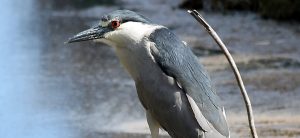Featured research from the Hechinger Lab: The conclusion represents a new line of thinking in parasitology.

Birds like this black-crowned Night Heron were studied to understand their parasite load. Photo: Andrew Turner/Ryan Hechinger
A team of ecologists at Scripps Institution of Oceanography at UC San Diego has made a breakthrough that has implications for multiple fields within biology as well as epidemiology.
Ecologist Ryan Hechinger and colleagues tested a new way to predict the parasite load carried by California shorebirds they collected and analyzed. The principles they describe, however, could apply to any organism that hosts parasites, including humans. Hechinger describes parasites as the “dark matter” of ecosystems: they are ubiquitous and a key component of energy flow through those systems, but their ecological function is often overlooked.
The study appears today in the journal Proceedings of the Royal Society B. In it, Hechinger’s team – including Kate Sheehan, a former postdoctoral researcher in Hechinger’s lab now at Frostburg State University in Maryland, and Hechinger Lab Manager Andrew Turner – describes how the amount of space inside or on a host, whether it be an ostrich or hummingbird, elephant or mouse, has less to do with the total parasite load it can carry at any given time and is more related to how much energy it can supply to those parasites.
https://scripps.ucsd.edu/news/how-many-parasites-can-bird-carry

